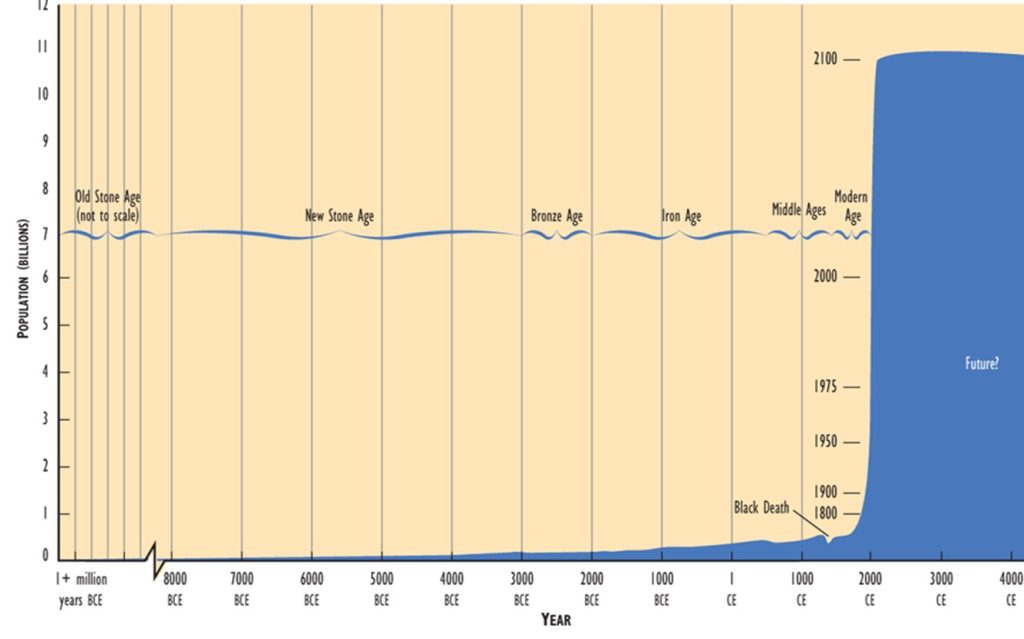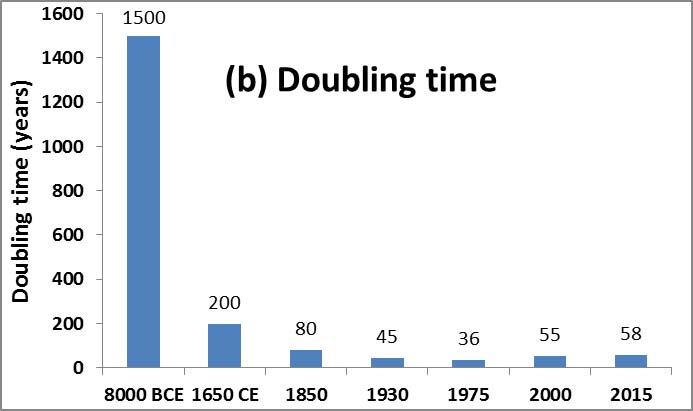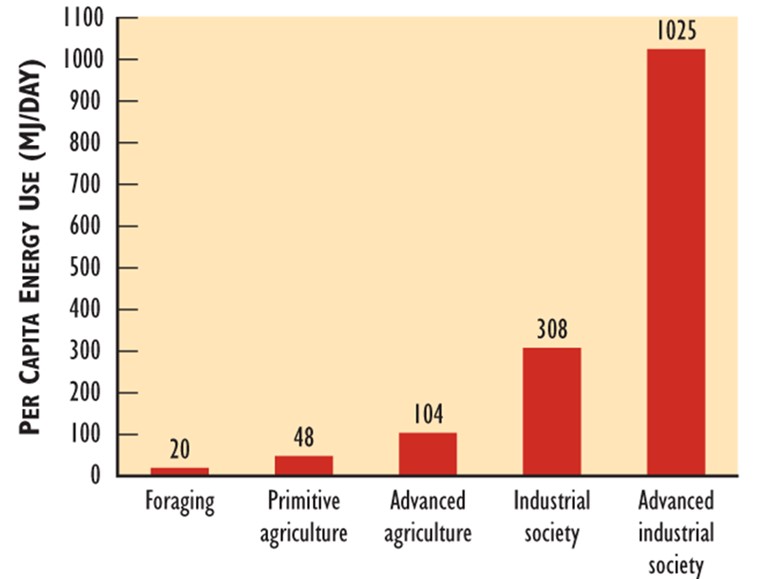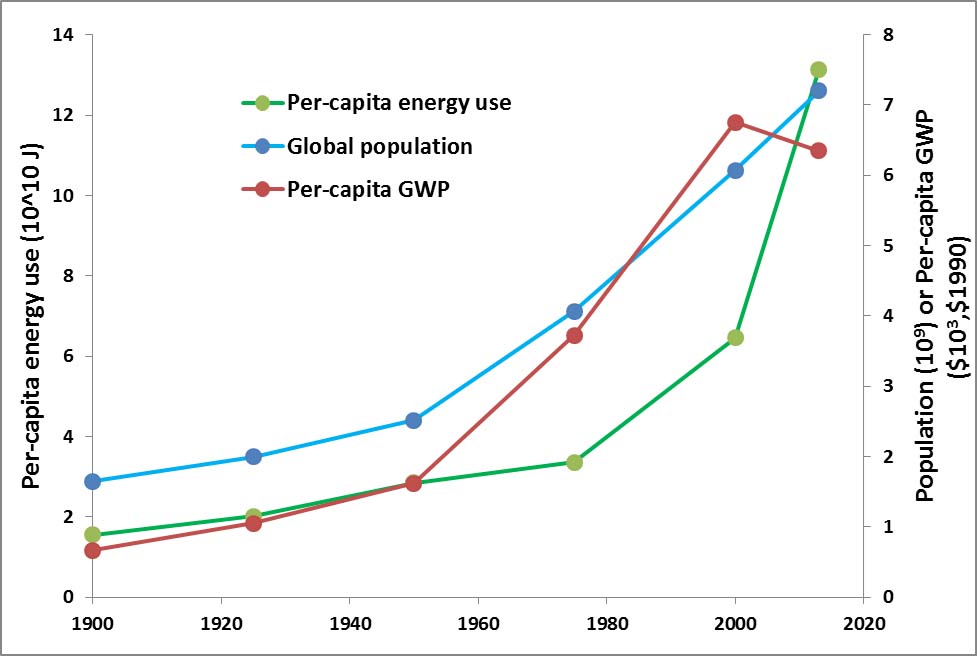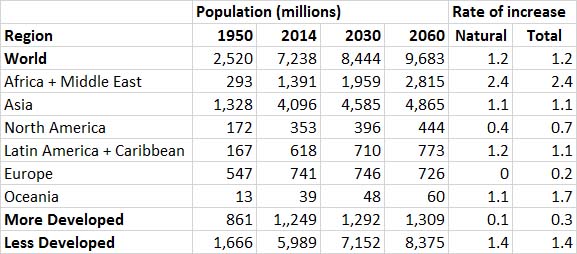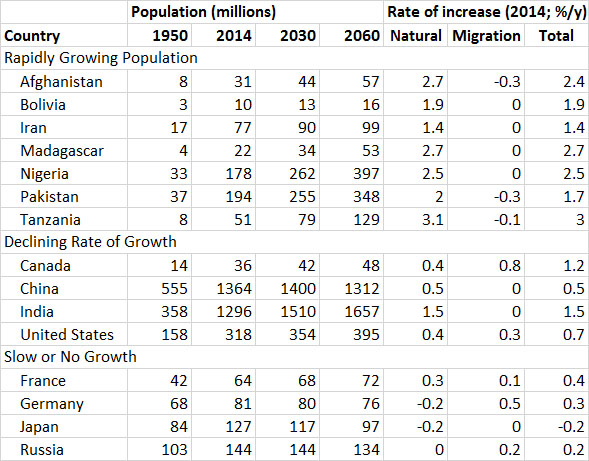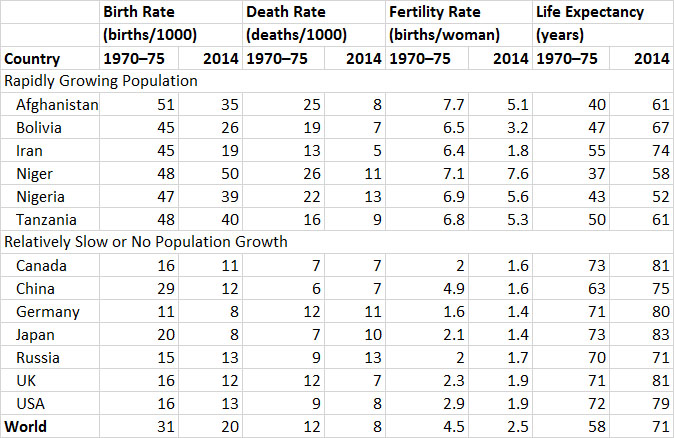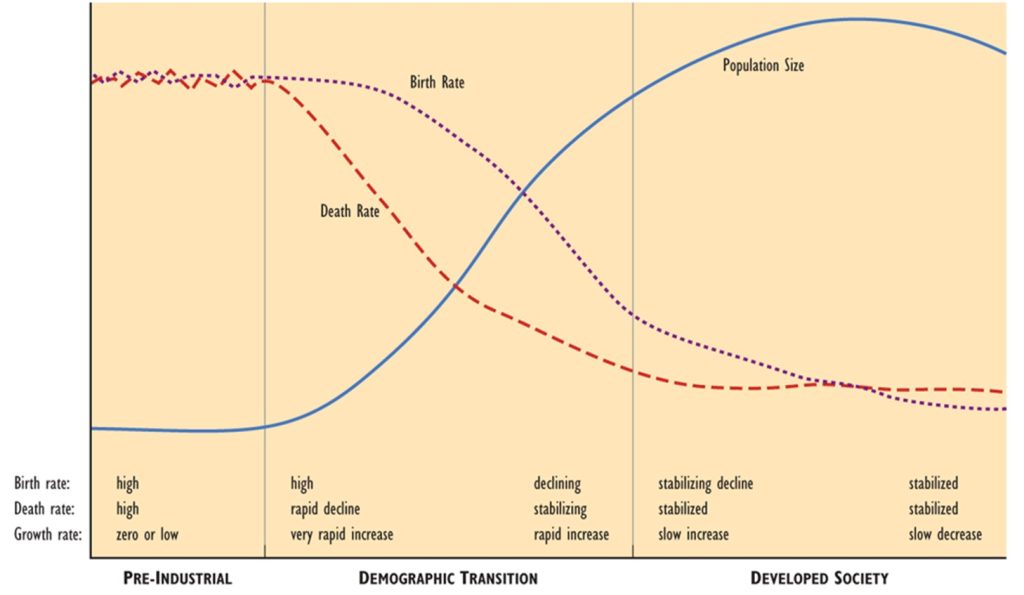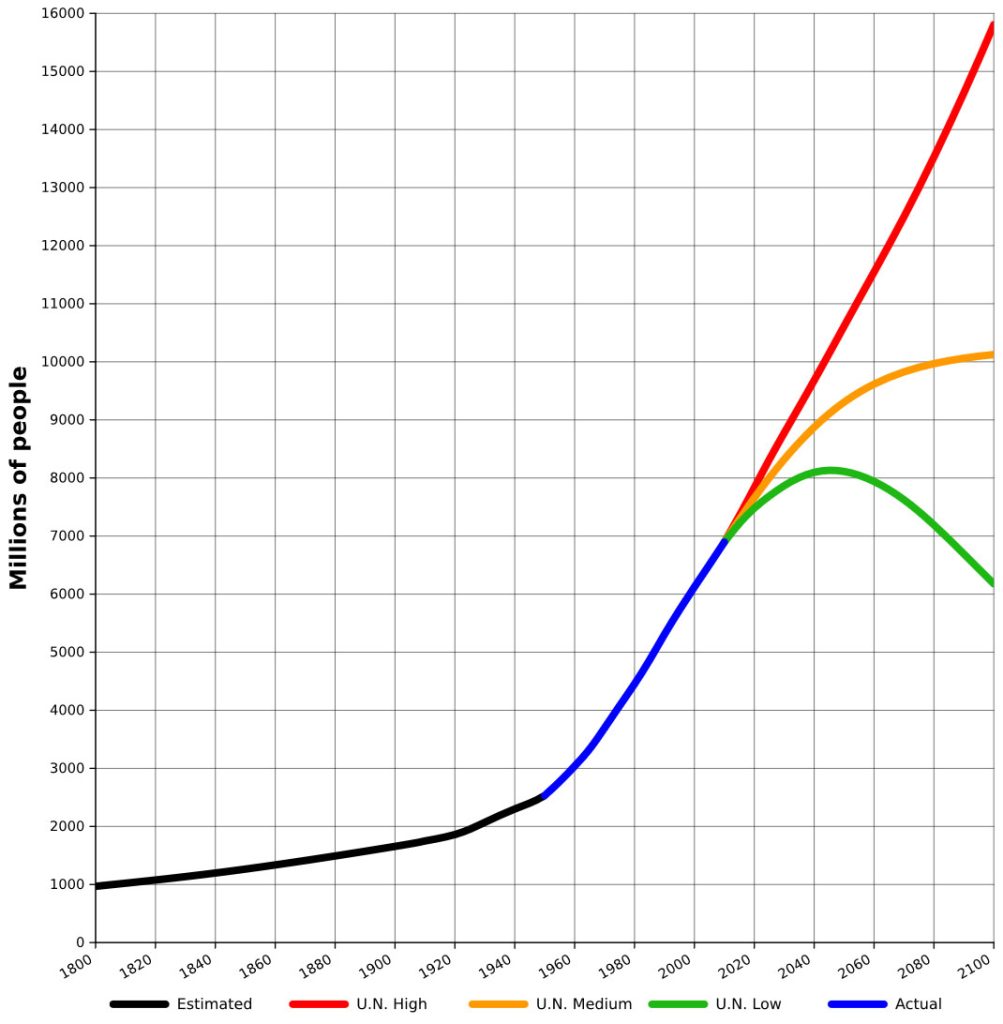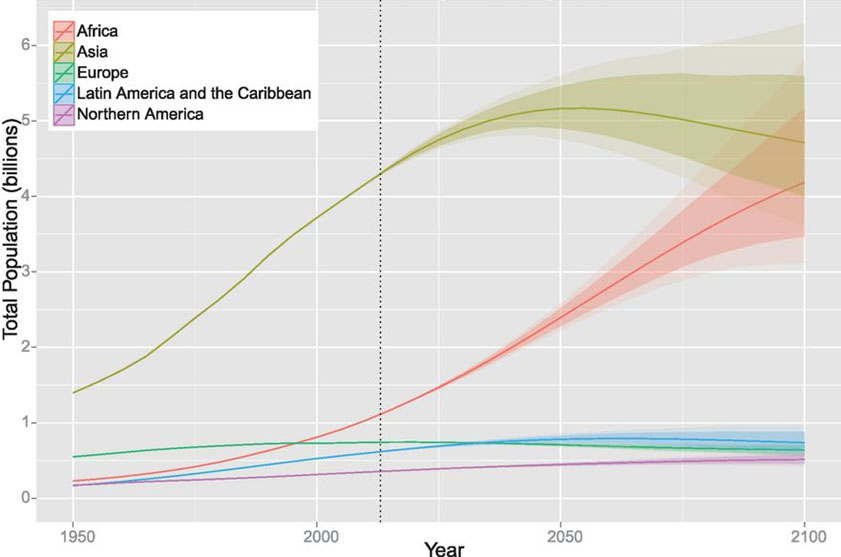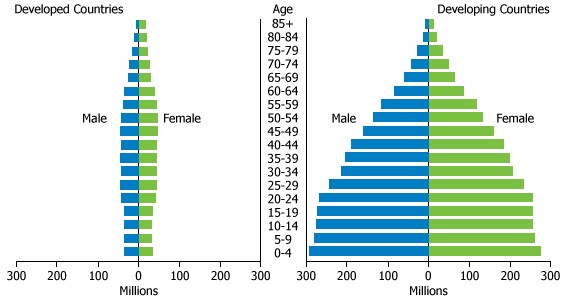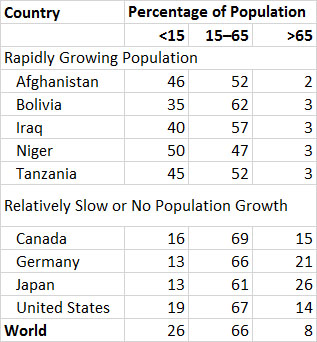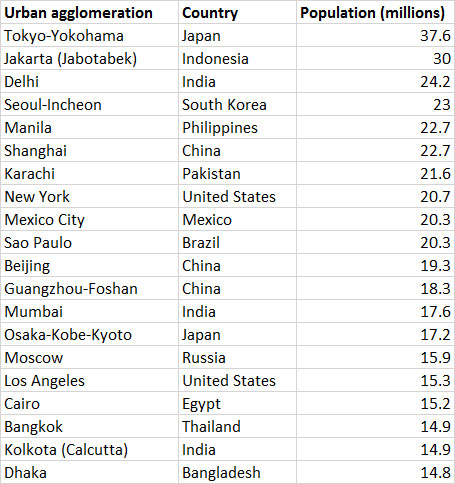Chapter 10 ~ Global Populations
Key Concepts
After completing this chapter, you will be able to
- Outline the process of cultural evolution and explain how it has increased the carrying capacity for the human population.
- Describe the growth of the human population during the past 10,000 years.
- Explain why population growth has been especially rapid during the past several centuries.
- Discuss why there are large differences in population growth rates between developed and less-developed countries.
- Explain the demographic transition and how it affects age-class structure and population growth.
- List the major methods of birth control, and discuss why they are controversial.
- Explain what a population policy is, and how it can affect future human population.
- Outline possible causes of a population crash.
Introduction
About ten-thousand years ago, only a few million humans were alive. Since then our population has grown enormously – in 2015, there were more than 7.3 billion, and the number is climbing steadily (by about 86.6 million, or 1.2% per year). In terms of consequences for the biosphere, the enormous growth of the human population is the most important event to have occurred since the end of the most recent continental-scale glaciation, which ended about 12,000 years ago.
Although the global population of humans has been increasing for millennia, the growth rate been particularly rapid during the past few centuries. Moreover, there is every indication that the present, extremely large population will continue to increase for at least another 50-100 years. Several possible scenarios of future population growth will be examined later in this chapter.
The environmental consequences of any human population are a function of a number of interacting factors, but two are especially important: the number of people and their per-capita environmental impact. The per-capita impact is related to both the lifestyles of individual people and the level of technological development of their society. These both affect the use of natural resources, the production of wastes, and the degradation of ecosystems (see also Chapter 1).
The growth of the human population during the past several millennia is a remarkable phenomenon, and its scale may be unprecedented during the history of life on Earth. This inference is based on the following observations:
- the population growth has been sustained over a long period of time
- an extraordinarily large abundance has already been achieved
- there has been a similarly impressive population growth of species that live in a close, mutualist relationship with humans, such as cows, pigs, chickens, and agricultural plants, which have their own cumulative environmental impacts
- a remarkable variety of species and ecosystems is being exploited as natural resources to support the human enterprise
Image 10.1. The human population is growing rapidly and now numbers more than 7 billion. This scene shows an urban market in Hong Kong. Source: B. Freedman.
In large part, these phenomenal achievements of Homo sapiens have been realized through the profound benefits of cultural evolution (or socio-cultural evolution). This term refers to the progression, throughout human history, of a series of adaptive discoveries of increasingly sophisticated tools and social systems. The capacity of people to learn from the experience of others, including the transmission of knowledge from one generation to the next, has allowed cultural evolution to proceed. In turn, this adaptive process has allowed people to become increasingly more efficient in the capture of natural resources by exploiting other species, ecosystems, and non-renewable materials (Chapter 12). Cultural evolution has allowed humans to achieve an unparalleled success in their domestication of planet Earth.
Unfortunately, the remarkable growth of the human economy (which represents increases in both population and per-capita environmental impact) has also caused terrible damage to the biosphere. Much of this damage has resulted in a large reduction in the carrying capacity for people and their enterprise. Moreover, natural ecosystems have been severely reduced in area, a change that is causing a massive loss of innumerable other species (see Chapter 26). In its totality, this damage already represents a global environmental crisis, and it is still worsening. Regrettably, the impressive growth of the human enterprise through cultural evolution has largely been achieved by reducing the ability of the biosphere to support most other species and natural ecosystems.
It is important to understand that the increasing size of the human population is not, on its own, the root cause of the environmental crisis. The rapid escalation of per-capita resource use and waste production is at least as important. Nevertheless, However, a sustainable resolution of the environmental crisis cannot be achieved if the explosive growth of the human population is not dealt with.
In this chapter we examine the remarkable changes that have occurred in the abundance of people during the past 10,000 or so years, and how cultural evolution has further increased the intensity of resource use. We also look at predictions of population change into the near future. Global patterns of change are emphasized in this chapter; we will examine the population of Canada in Chapter 11.
Cultural Evolution and Carrying Capacity
The biological history of hominids, including Australopithecus africanus, extends to perhaps 4 million years. The genus Homo goes back about 2 million years; Homo sapiens, the only surviving species, is about 200,000 years old.
For almost all of the evolutionary history of our species, relatively small numbers of people were engaged in subsistence lifestyles – they foraged over large areas while hunting wild animals and gathering edible plants. These people roamed the landscape in small family groups, searching for food and other necessities and using simple weapons and tools made of bone, stone, wood, and other natural materials. The hunter–gatherer lifestyle characterized the first 95% or so of human history, and during that lengthy time the population of our species was probably fewer than 1 million individuals.
By some 12-15-thousand years ago, people had discovered all of the major habitable landmasses, including the Americas. The latter were colonized relatively late, when small groups roved eastward across a broad (up to 1000 km wide) but temporary land bridge that connected Siberia and Alaska, through a region that is now the Aleutian Islands. That bridge was still present as recently as 11,000 years ago, and it existed because so much of global water was tied up in glaciers on land that sea level was about 110 m lower than it is now. (Note, however, that some archaeologists believe there may have been an earlier colonization of the Americas, occurring up to 60,000 years ago.) The wandering Siberians discovered a landscape with bountiful resources that had never before been exploited by people. Descendants of those first colonists of the Americas spread quickly, in the manner of an expanding wave, to occupy and exploit all habitable regions of North, Central, and South America. Occurring at the same time as the colonizing surge of people was a mass extinction of many species of large mammals and birds. It is likely that these unfortunate animals were naive to the lethal prowess of the novel two-legged predators that hunted in well-coordinated packs, and they were unable to adapt to the onslaught (Chapters 12 and 26).
Cultural evolution has been a pervasive characteristic of our species, and there were many adaptive innovations of society and technology during the long-lasting prehistoric phase of foraging societies. These were cumulative advancements, meaning that each innovation built upon earlier ones and so the tools, practices, and social organizations got better and better. The innovations allowed natural resources to be exploited more efficiently, and economies of increasing size and complexity to be supported. The key advances of these prehistoric times, which because of their immense influence are sometimes referred to as “revolutions” (or great forward steps) of cultural evolution, include the following:
- the invention and improvement of tools and weapons
- discoveries of edible and medicinal species
- the elaboration of language and other means of communication
- the development of improved social organizations
- the mastery of fire
- the domestication of the dog, which allowed hunting to be more efficient, provided a pack animal, and helped keep encampments clean
Each of these breakthroughs enhanced the ability of people to exploit natural resources. This increased the effective carrying capacity of the ecosystems they were utilizing and allowed the population to increase and the overall economy to grow. By the end of this period (9-10-thousand years ago), when most people still engaged in foraging lifestyles, the global population was likely 1 to 5 million individuals.
At about that time, the first significant developments of primitive agriculture began, marking the beginning of a period known as the neolithic revolution (or the new stone age; see Figure 10.1). The first agricultural innovations included the beginning stages of domestication of a few edible plants and animals, such as barley and sheep, and the discovery of simple ways to cultivate them to achieve greater yields. Because crops must be tended and protected, the adoption of agricultural practices meant that lifestyles had to be much more sedentary. The eventual achievement of predictable food surpluses allowed some people to be supported as non-agricultural workers living in villages. This social and economic change eventually fostered the development of city-states and then nation-states, along with their relatively sophisticated cultures and technologies.
Figure 10.1. History of Population Growth.
For most of the history of Homo sapiens, the global population was several millions or less. However, adaptive and cumulative innovations through cultural evolution allowed increasingly more efficient exploitation of natural resources to occur, so the effective carrying capacity for humans was increased. This process intensified greatly during the past several millennia, and especially in the past two centuries. The human population is now showing extremely rapid growth, of a magnitude that is probably unprecedented for any large animal in the history of the biosphere. The future levelling off of the population is conjecture. Source: Modified from Freedman (2010) and Population Reference Bureau (2015).
The development of agriculture and its associated socio-cultural systems was one of the great forward leaps of human cultural evolution. The neolithic revolution provided an enormous increase in the carrying capacity of the environment for people and their domesticated species. Steady population growth was a result of this change, because even the primitive agricultural systems of those early times could support many more people than could subsistence lifestyles based on foraging for wild plants and animals.
The initial development of agriculture was followed by further innovations that increased the yield of crops. These improvements included the domestication of additional species of useful plants and animals, their genetic improvement through selective breeding (or artificial selection), and the discovery of better ways of managing the environment to increase crop productivity. There were also many non-agricultural enhancements of the carrying capacity, including the discoveries of the useful properties of metals and their alloys, which allowed the manufacturing of tools and weapons that were far superior to those made of bone, stone, or wood. In addition, the domestication of beasts of burden and the invention of boats and wheeled vehicles made it easier to transport large quantities of valuable commodities, which greatly stimulated trade.
This brief outline suggests that the cultural evolution of human socio-technological systems has involved a long and cumulative series of adaptive discoveries and innovations. Each of them increased the ability of people to exploit the resources of their environment, which increased the effective carrying capacity and thereby fostered growth of the populations of people and their mutualist species, and of the overall human economy.
As a result of this adaptive progression, there were about 1-5 million people alive at the dawn of agriculture about 10-thousand years ago, 200–300 million at the beginning of the Common Era 2000 years ago (0 CE), and 500 million in 1650.
The rate of population growth then began to increase markedly, a trend that has been maintained to present times. These recent, extremely rapid increases in the human population have occurred for several reasons. Of primary importance have been the discoveries of increasingly effective processes and tools in sanitation and medicine, which resulted in great decreases in death rates. Ways of preventing lethal communicable diseases have been especially important in this respect.
In addition, recently discovered technologies have allowed for an increasingly effective harvesting of natural resources, the manufacturing of improved products, and greatly improved methods and infrastructure for transportation and communications. These have been achieved as a result of the industrial revolution, which began in the mid-eighteenth century. Agricultural systems have also been greatly improved through the development of improved crop varieties and better methods of cultivation, which have resulted in substantial increases of yield. Again, all of these progressions of cultural evolution have further increased the carrying capacity of the environment for people.
Between 8000 BCE and 1650 CE, the human population increased from about 5 million to 500 million, with an average doubling time of 1500 years and a growth rate of 0.01% per year (Figure 10.2). Since then the population has increased greatly and the doubling times have become less. The global population reached 1 billion in 1850, 2 billion in 1930, 4 billion in 1975, and 7.3 billion in 2015.
Figure 10.2. Growth and Doubling Times of the Human Population. Sources: Data from Ehrlich et al. (1977) and Population Reference Bureau (2015).
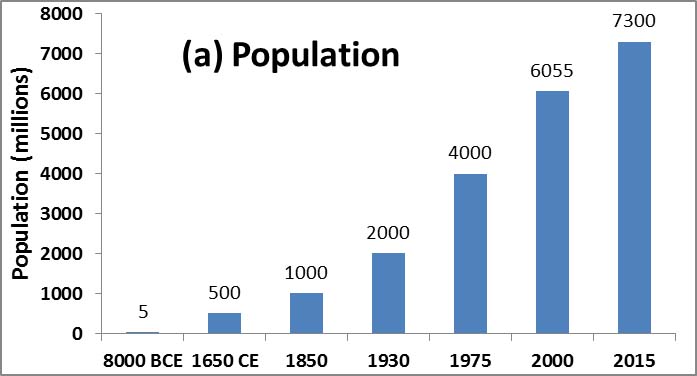
The population growth rate was at a historical maximum of about 2.1% per year during the late 1960s. At this rate of increase, the population is capable of doubling in only 33 years. Since then, the growth rates have slowed somewhat, to about 1.2% in 2015. If maintained, however, even that rate of increase would double the population in only 58 years. In fact, there is now an annual net addition of about 79 million people to the global population. For context, this annual increase is equivalent to about 2.3 times the population of Canada.
The cultural evolution of social, technological, and economic systems has allowed many people to enjoy great improvements of lifestyle. The main advancements have been in food and health security, which are a result of better access to sanitation, health care, food, shelter, and other elements of subsistence. (In the sense meant here, “security” is related to having access to the necessities and amenities of life, which enhances the likelihood of living to old age and raising healthy children.) The quality of life has also been improved through improved access to aesthetic resources and amenities, such as culture and recreation. Of course, these betterments of lifestyle are not shared equally among all people – they are largely unavailable to enormous numbers of poor people.
This is not to say that hunter-gatherers did not enjoy aspects of their lifestyle. These people undoubtedly had a rich cultural life, and many were able to satisfy their subsistence needs by “working” only a few hours each day, leaving much time for relaxing and socializing. In fact, the transitions to agricultural and then industrial societies have involved considerably greater workloads for average people and less time for relaxation. The additional work has, however, reaped benefits of the sort noted above, and for much larger numbers of people.
It is important to understand that the many improvements in human security and lifestyle have involved a great intensification of the per-capita environmental impact. We can easily understand this important change by examining patterns of energy usage, which is a simple indicator of per-capita impact (Figure 10.3; see also Chapter 1). Compared with hunter-gatherers, people living in an advanced technological society use at least 50 times more energy, and their environmental impact is greater by a similar degree.
Figure 10.3. Cultural Evolution and Energy Use. These data are estimates of the per-capita use of energy by people engaged in various kinds of lifestyles. Energy use is presented here as a simple indicator of environmental impact. Source: Modified from Goldemberg (1992).
The intensification of the per-capita use of energy has been especially great during the past century of accelerating technological development. In fact, during the past century, the global per-capita economic output and energy use have both increased at similar or greater rates as the human population (Figure 10.4). These per-capita increases have, of course, been especially rapid in developed countries such as Canada, and much less so in poorer countries (see Chapters 13 and 14). For instance, the per capita consumption of energy in developed countries averages about 194 gigajoules/year (GJ/y), compared with 38 GJ/y in less-developed ones (WRI, 2008). Although developed countries account for about 20% of the human population, they are responsible for 59% of the global consumption of energy.
Figure 10.4. A Century of Change in Global Population and Per-capita Environmental Effect. Global-scale economic activity and energy use are being used here as simple indicators of the environmental impact of a human population. Economic activity is given in constant US$ (year 1990), so inflation does not account for the increase over time. Sources of data: DeLong (1998), Population Reference Bureau (2015), and BP (2014).
It is important to remember that the rapid increases of population and per-capita environmental influence multiply together to determine their total effect. For example, population is multiplied by the per-capita economic activity to calculate the gross world product (GWP), or the sum of the economic activities of all people in the world. Using this calculation, the data in Figure 10.4 suggest that the GWP in 2013 was about 42 times larger than in 1900 ($41.7 × 1012 versus $1.1 × 1012; note that to account for inflation, both of these values are in constant year-1990 US$; note the 2013 data, if expressed in year-2013 dollars, would be $71.8 × 1012; note also that 1012 is a trillion, or a thousand billion). This is much larger than the growth of population during that same period (4.3 times larger), and also that of per-capita economic activity (9.5 times larger).
A similar calculation can be made for global energy consumption, again using data from Figure 10.4. If we do this, we determine that global energy use was about 40 times larger in 2013 than in 1900. Because of the multiplication effect, this is much larger than the growth of population during that period (4.3 times larger) or of per-capita energy use (8.5 times larger).
Global Focus 10.1. Population in Context
The abundance of humans in 2015 was more than 7.3 billion individuals. That enormous population was growing by about 1.2% per year, equivalent to an additional 87 million people each year. Although the rate of growth is slowing, it is projected that 9-12 billion people might live on Earth when the population eventually levels off. These are gigantic numbers, and to put them into perspective it is useful to consider the abundance of other species of “large” animals (defined as weighing more than 44 kg, or 100 pounds).Some large animals have been domesticated and live in a mutualism with humans. The most populous of these are cows (Bos taurus and B. indica) with a population of about 1.5 billion, sheep (Ovis aries) with 1.2 billion, goats (Capra hircus) with 1.0 billion, and pigs (Sus scrofa) with 1.0 billion (FAO, 2015). Some smaller mutualists are even more abundant, including an estimated 22 billion chickens (Gallus gallus).
It is doubtful that any wild, large animals ever had such enormous populations as do humans and our domesticated animals (Freedman, 2010). Within historical times, the most populous wild, large animal was the American bison (Bison bison), which prior to its near extermination by over-hunting, may have numbered 60 million individuals. At the present time, the most populous large animals in the wild are the white-tailed deer (Odocoileus virginianus) of the Americas with 40-60 million individuals, large kangaroos in Australia (Macropus gigantea and M. rufus) with up to 50-60 million, and the crabeater seal (Lobodon carcinophagus) of the Antarctic with 15 million. The populations of these wild animals are only 1% or less of that of humans.
A few other wild species of large animals maintain populations in the millions, including as many as 7 million ringed seals (Phoca hispida) in the Arctic, 7-8 million harp seals (Phoca groenlandica) in the North Atlantic, and 3 million caribou (reindeer, Rangifer tarandus) in the Arctic and Subarctic.
Clearly, humans and their large-animal mutualists are unusually abundant, and even unnaturally so. The huge populations of domesticated animals (humans included) can be maintained only by using an extremely large fraction of the productivity of Earth’s ecosystems. Some ecologists have estimated that fraction to be as large as one-quarter (Vitousek et al., 1986; Haberl et al., 2013).
Regional Variations
It is important to recognize that population growth varies enormously among regions and countries. In recent decades, some countries have achieved a natural rate of growth (birth rate minus death rate) as high as 4% per year, which if maintained could double their population in only 18 years.
Populations are growing most quickly in Africa, with a rate of increase of about 2.4% per year (Table 10.1). Although African countries vary considerably, as a whole, the continent is the world’s poorest region. Its socioeconomic condition is partly due to legacies of its colonial history, including national boundaries that often make little sense in view of the distributions of tribal and language groups. In some countries, other factors also detract from development, particularly endemic corruption in government and business and strife between tribes. In addition to those important problems, the increasing populations of African countries are also making it extremely difficult to deal with chronic poverty. The population of continental Africa was about 224 million in 1950, 1,136 million in 2014, and an anticipated 2,428 million (or 2.43 billion) in 2060. With human populations increasing so quickly, and the amounts of agricultural land and other resources remaining static or even declining because of over-exploitation, it will be a formidable challenge to avert social and ecological catastrophes in many African countries. Resolving these problems will require both national fortitude and generous international assistance.
Table 10.1. Regional Population Growth. Data for 2025 and 2050 are estimated from recent demographic trends (i.e., in rates of birth, immigration, death, and emigration). The natural rate of population increase (in 2014, data in percent) is calculated as births minus deaths, while the total rate also accounts for net migration. Data are from World Resources Institute (2008) and Population Reference Bureau (2015).
Populations are growing least quickly in Europe, where the present change is about 0.2% per year, a rate that is expected to hold for several decades (the rate of natural change is 0.0%/y, while net immigration is 0.2%/y). Populations are growing somewhat more quickly in North America, currently at 0.7% per year (the natural increase is 0.4%/y, while net immigration is 0.3%/y).
Much of the population growth in Canada and the United States is due to relatively open levels of immigration from other countries rather than to natural population change (see Chapter 11). The major source regions of the immigration are Asia, Central and South America, and Africa, mostly from countries with growing populations and few prospects for poor people to improve their lifestyle. Immigration is also coming from parts of eastern Europe where there is little population growth but much unemployment and economic hardship.
Populations of Particular Countries
Data for recent population growth in selected countries are listed in Table 10.2. Countries with the fastest increases in population are in Africa and Asia, and to a lesser degree, in Central and South America. Populations are increasing rapidly in almost all countries in those regions.
Table 10.2. Population Growth in Selected Countries. Data are from World Resources Institute (2008) and Population Reference Bureau (2015).
There are, however, some anomalous situations whose dynamics are largely driven by the movements of large numbers of refugees. For instance, Afghanistan had a population decrease of 1.8% per year during the period 1980 to 1985 (WRI, 2008). This was mostly because a devastating civil war killed many people, while even larger numbers fled to neighbouring Pakistan and Iran. In contrast, the population of Afghanistan increased by an extraordinary 6.9% per year during 1990–1995, largely because many refugees migrated back after a sporadic ceasefire restored relative peace. Overall, the intrinsic rate of increase of the Afghani population has been 2.7-3.5% per year. In 1950, the population of Afghanistan was 8 million. By 2014 it had increased four-fold to 31 million, and it is projected to reach 44 million by 2030 and 57 million by 2060.
Some countries have had recent population growth even more rapid than Afghanistan. In Nigeria, for example, the population was 33 million in 1950 and is projected to reach 262 million in 2030 (about an 8-fold increase) and 397 million in 2060 (12-fold). (Note, however, that such predictions for Nigeria and some other countries could prove inaccurate because of mortality from the AIDS epidemic or some other disaster; see the last section of this chapter and Global Focus 10.2). In Iran, the population increase between 1950 and 2030 is projected to be about 5-fold. Try to imagine the ecological and resource stresses associated with population explosions like these! Contemplate being a politician or governmental bureaucrat who is charged with the responsibility of ensuring livelihoods and an acceptable quality of life for so many citizens, while also protecting the environmental quality and ecological heritage of the country! The challenges are daunting.
The countries with the most stable populations are mainly in Europe. The populations of most European countries are growing at less than 0.5% per year, and the doubling times are longer than 100 years. As was previously noted, the intrinsic rates of population increase in Canada and the United States are similar to these values, although because of substantial immigration, their populations are still growing at about 1% per year.
Fortunately, many countries are showing rapid decreases in their rate of population increase. China, for example, had population growth rates exceeding 3% per year in the 1960s and 1970s, but this decreased to 0.5% per year in 2014. The slowdown is occurring because the government of China has recognized the acute problems associated with population growth, and so has developed policies to slow the increases and is implementing them in an effective manner. However, China’s government has imposed its population policy with a determination that has sparked debates about human rights. Controversial measures have included coerced sterilization and the enforcement of a one-child-per-family guideline, particularly in urban areas. Nonetheless, China appears to be firmly on the road to rapidly decreasing its rate of population growth. We can only hope this necessary action has occurred in time. China’s population in 2050 was 555 million, but this had more than doubled in 2014 to 1.4 billion, and even with its aggressive population policy this could still increase further. These are immense numbers of people to accommodate within the bounds of the landmass and natural resources of China, which are not increasing in area or quantity.
The situations in Brazil, India, Indonesia, Korea, Mexico, and Thailand are similar, although none of these countries is experiencing declining rates of population growth as rapid as that of China. India, the world’s second-most populous country, had 1.3 billion people in 2014, and may somehow have to support 1.5 billion in 2030. Although all of these countries have started to develop population policies aimed at reducing growth rates, they are not being implemented as effectively as in China.
In general, countries that are experiencing the most rapid population growth are relatively undeveloped and poor, and they are tropical or subtropical in distribution. However, not all poor countries have high population growth rates. The population growth rates of Cuba, for example, have been consistently less than 1% per year since the 1950s. Although Cuba is relatively poor, almost all of its citizens are literate and its social system provides ready access to housing, food, social security, and health care, including effective means of birth control.
It can be broadly generalized that the wealth and state of development of nations correlate inversely with their population growth rate. Nevertheless, any country with an appropriate and effectively delivered population policy can achieve a strong measure of control of the rate at which its population is increasing. The case of Cuba demonstrates this fact.
The explosive rates of population increase in so many poor countries are straining the ecosystems that must somehow sustain the burgeoning numbers of people and their livelihoods. This can be illustrated by the case of Sudan, in northeastern Africa. The population of Sudan was 2.9 million in 1917, but it had irrupted to 38 million by 2006, an increase of 6.4 times (Olsson and Rapp, 1991; WRI, 2008) (an irruption is a rapid increase). Because most Sudanis are engaged in agricultural livelihoods, the populations of livestock also increased tremendously during that period. The number of cattle increased 51-fold (to 41 million); camels, 17-fold (to 3.9 million); sheep, 39-fold (to 50 million); and goats, 35-fold (to 43 million). These enormous amounts of growth in the populations of people and livestock have degraded the carrying capacity of rangelands in Sudan and other regions of Africa. At the same time, terrible damage has been caused to natural ecosystems.
It must be remembered, however, that comparable rates of growth occurred in Europe and North America in previous centuries. In Britain, for example, extensive deforestation and other habitat losses resulted in the extirpation of many species of native plants and animals. In addition, deforestation and the grazing of hillsides in Scotland virtually eliminated the native forest that once covered that landscape, although there has since been some replacement by conifer plantations. These ecologically destructive activities have largely been forgotten, and most inhabitants of Britain now regard the transformed landscape of their country as being “natural.” Comparable stories can be told of regions of southern Canada that were once extensively forested, but are now covered by urban and agricultural land-uses, with only small areas of degraded “natural” habitat.
Birth and Death Rates
Societies living in relatively primitive, undeveloped conditions have always tended to have high rates of births and deaths, typically about 40-50 per thousand. (Birth and death rates are commonly expressed as the average number per thousand individuals in the population per year.) These were the usual rates of natality (births) and mortality (deaths) throughout almost all of human history. As long as the rates of births and deaths remained high and similar to each other, the population growth was small or zero. It is only during the past several centuries that rapid growth has occurred.
This has occurred largely because death rates have decreased substantially in all countries. The large reductions of death rate are due to the benefits of improved sanitation, medicine, immunization, and social welfare, along with widespread access to education (which, among other things, provides a widespread awareness of the benefits of sanitation and medicine).
The life-saving benefits of sanitation, immunization, and medicine are particularly consequential for younger people, especially those less than five years old. This group tends to have the highest death rates under “primitive” conditions. Other relatively vulnerable groups that have benefited include the elderly and women in childbirth. As well, large reductions in mortality from infectious diseases, such as bubonic plague, diphtheria, influenza, malaria, plague, smallpox, tuberculosis, and yellow fever, have been important in reducing mortality during the past several centuries.
However, these medical and social benefits have not been shared equally among countries, or among income groups within nations. For this reason, people living in less-developed countries, and poorer income groups within countries, typically have considerably higher death rates than do more-developed or wealthier ones. This trend is readily apparent if data for death rates in poorer countries with increasing populations are compared with those of wealthier countries having more stable populations (Table 10.4).
Compared with the relatively large decreases of death rates in all of countries and cultures, decreases in birth rates have been much slower (Table 10.3). In general, the wealthiest, most developed countries have relatively low birth rates, with rates typically about 10 per thousand. Moreover, these are almost in balance with death rates, so the natural population increase in those countries is low or zero. In large part, the relatively low birth rates of the wealthier countries have resulted from the emergence of a cultural inclination to have small families, which can be achieved because there is ready access to safe and effective methods of birth control.
Table 10.3. Demographic Information for Selected Countries. Note that the intrinsic rate of population change is calculated as the birth rate minus the death rate. A difference of +10 units is equal to a 1% increase per year. The fertility rate is the number of children born to an average woman over her lifetime. Life expectancy is the number of years lived from birth. Data are from World Resources Institute (2008) and Population Reference Bureau (2015).
Changes in cultural attitudes about family size appear to be a natural outcome of increasing affluence and health as societies develop and become wealthier. Such cultural changes are critically important for dealing with the potentially explosive population growth of modern times. In a sociological sense, however, it is not exactly known how these changes in attitude come about. In less-developed societies, children are often viewed as a source of inexpensive labour and providers of material comfort for their parents in old age. In contrast, in wealthier societies, children are considered to be substantial economic and social responsibilities for their parents – they are expensive consumers of space, education, energy, food, clothing, and other necessities. This context provides a strong incentive for having a smaller family.
Although birth rates have recently been decreasing, they are nevertheless quite high in most less-developed countries. Because death rates have fallen considerably, their populations are growing rapidly (see Table 10.4). In general, birth rates have remained high because of cultural preferences for larger families – this factor is strongly influenced by high death rates in recent history, particularly of young children. Fifty years ago, a family might have had six birthed children, with only three surviving because of a high rate of infant mortality. Today, however, all six might survive. In addition, some religions influence birth rates because they promote large families or strongly disapprove of modern methods of birth control. The social factors result in a lag in the cultural adjustment of birth rate to offset the rapid declines in mortality. The ensuing imbalance has resulted in the rapid population growth that is occurring in almost all less-developed countries.
However, the situation is not quite as simple as this. In many countries, the fertility rate is maintained at a considerably higher level than many people, particularly women of childbearing age, might freely choose. This happens because many women do not have sufficient access to safe and effective means of birth control. Exceptions are countries such as China and Cuba, and to a lesser degree Brazil, India, Indonesia, Korea, Sri Lanka, and Thailand, all of which are substantially reducing their population growth rates, mainly by ensuring that their citizens have access to effective means of controlling their fertility.
The Demographic Transition
Almost all of human history has been characterized by relatively primitive living conditions, and during that time there was low or zero population growth (ZPG) because high death rates were balanced by high birth rates. During the past several centuries, however, many countries have had rapid population growth because the rate of births exceeded that of deaths. More recently, during the past five decades or so, a condition of ZPG has occurred in relatively “developed” nations and cultures, in which low death rates are balanced by low birth rates.
The so-called demographic transition refers to the transition of a population from a condition of high birth and death rates to another of low birth and death rates (Figure 10.5). It typically takes a rather long time, usually several generations, for a society to make it through this transition, and while that is happening the population increases at a high rate. The imbalance occurs because modern sanitation, immunization, and medicine contribute to a rapid decrease of mortality, but that occurs without a simultaneous off-setting decrease in birth rates. If, for example, the annual birth rate remained at 45 per thousand while the death rate declined to 11 per thousand, the population would grow at 3.4% per year. If that situation continued, the population would double in only 20 years. These numbers are, by the way, actual demographic parameters for Zambia in 2014, one of the least-developed countries in the world.
Figure 10.5. The Demographic Transition. This illustration models the transition from a condition of high birth and death rates to one of low birth and death rates. Typically, the death rates decrease faster than birth rates, and the corresponding imbalance has an explosive influence on population growth. Zero population growth occurs when birth and death rates offset each other. If the birth rate falls below the death rate, the population will decrease in size.
No cultures prefer high death rates, but some do have a preference for larger families. Recent history has shown that it takes one or two generations to overcome cultural inclinations toward having large families, and for birth rates to decline to a level that is in balance with modern death rates.
Many of the developed countries of today had the great fortune of passing through their demographic transition during times when their populations were relatively small, and under circumstances in which their “surplus” people were able to migrate to other places. At the time, many European countries had a surfeit of labourers because of mechanization associated with the beginning of the Industrial Revolution, as well as the consolidation of small farms into larger ones, which also deprived large numbers of people from employment. To escape their poverty and dim prospects, many people chose to emigrate to colonial “frontiers” in the Americas, Australia, and elsewhere. Many countries, such as Argentina, Australia, Brazil, Canada, Chile, Mexico, New Zealand, South Africa, the United States, and Venezuela, were then colonies of European nations. At the time, these were considered to be “underpopulated” places with bountiful resources, capable of assimilating a large amount of immigration.
In actual fact, however, at the time of their European “discovery” these regions were already occupied by indigenous peoples. Nevertheless, in the socio-political context of the time (16th to 19th centuries), European powers seized ownership of many foreign regions, displaced or subjugated the original inhabitants, and colonized the freed-up land through an immigration of poor or otherwise mobile citizens from the home countries. To a substantial degree, the notion of under-population lingers today, particularly in Canada, the United States, and Australia, which still allow relatively high rates of immigration of people from other countries. As a result, the population growth rates in those countries substantially exceed what would be expected based on birth and death rates, which are almost in balance and reflect passage through the demographic transition.
In recent centuries, immigrants from a great many countries have swelled the populations of Canada and the United States. For example, at the time of the first United States census, in 1790, that country had a population of 4 million. Sixty years later, in 1850, the population had increased to 23 million. That growth was largely achieved through immigration of many people from Britain and other European countries. (The natural increase in population during that period was also vigorous, adding 4-8 million people.) Changes of a similar degree occurred in Canada (see Chapter 11). The ability of many European countries to export so much of their surplus population was critical to their relatively smooth passage through the demographic transition.
Today, only a few countries still allow a substantial rate of immigration, most notably Canada, the United States, and Australia. However, the actual numbers of people involved in transnational immigration to developed countries, several million per year, is small in comparison with the global population growth (about 87 million per year in 2014). Moreover, there is no reason to expect that these and other host nations will continue to be willing, or able, to absorb population surpluses from other countries.
One of the bitter truths of modern times is that the relatively poor, less-developed countries of the world, which have the fastest population growth, have no significant outlets for their burgeoning surpluses of people. All nations today have access to the mortality-reducing benefits of modern sanitation and medicine, but in most countries these are not yet balanced by a control of birth rates. Consequently, many less-developed countries are faced with a pressing need to bridge their demographic transition much more quickly than today’s developed countries ever had to do. Moreover, this daunting feat must be accomplished without much emigration. There are no underpopulated frontiers left on Earth – local population crises can no longer be exported somewhere else.
Future Populations
All trends in demographic indicators indicate that the human population will continue to grow rapidly into the foreseeable future. However, there are convincing signals of decreasing rates of population growth in almost all countries. This is encouraging, but it does not negate the fact that the global population is still growing rapidly (although not as quickly as several decades ago).
It is never possible to accurately foretell how complex phenomena, such as changes in human populations, will unfold in the future. Nevertheless, by extrapolating from recent trends it is possible to infer the likely values of birth and death rates and other demographic variables in coming decades. Such predictions can then be modified according to anticipated changes in social policies that may influence birth or death rates.
There is also, of course, the possibility that some catastrophic event or environmental deterioration could cause a massive increase in human death rates, resulting in a population crash. Such a calamity might be caused by a newly emerged virulent disease, a collapse in the availability of vital resources, a nuclear holocaust, or some other global emergency. However, events such as these are unpredictable and can never be forecast with accuracy – the most that can be suggested is that they may occur at some time in the future.
Population scientists have developed sophisticated mathematical models to predict the future abundances of humans. These models can be run using various demographic scenarios, for example, by changing the values of birth rate, death rate, population structure, or other variables. These models are not catastrophist – rather, they assume that future population size will be determined by relatively small changes in birth and death rates and not by a huge increase in death rates (i.e., a population crash).
Figure 10.6 shows world population growth from 1800 to 2010, and three models of future growth to 2100. The models are low-, medium-, and high-level projections based on studies by the United Nations. The low-level model uses optimistic demographic predictions, such as assuming that effective population policies will be implemented rapidly and will allow stable populations to be achieved as quickly as can be hoped. This model suggests that the population will increase to about 8 billion around 2050 and then decline to 6 billion by 2100. The high-level model uses relatively conservative parameters, such as effective policies not being implemented until considerable time has passed, so that the necessary demographic transitions will take a long time to occur in rapidly growing populations. This model forecasts a continuing increase of population to about 16 billion in 2100.
The medium-level prediction is perhaps most realistic because it uses more likely scenarios of political and economic factors that affect population policies and their influence on demographic parameters. This model suggests that the population will level off around 2100 at an abundance of 10 billion people.
Therefore, it appears that the global population will increase greatly from its present level before it (hopefully) stabilizes. This assumes, of course, that there is no intervening catastrophe such as a collapse of the environmental carrying capacity for our species, an unprecedented pandemic, or a global war.
Figure 10.6. The human population from 1800 to 2100. The data in black and blue are estimates to 2110, with those in blue being relatively accurate. Future populations are based on three population scenarios, ranging from low-level to high-level in terms of the assumptions of demographic parameters. The low-level model makes optimistic and probably unrealistic assumptions about population policies. The high-level model is more conservative and assumes that the imbalance between birth and death rates will be addressed more slowly. The medium-level model may be the most likely outcome, although there is considerable uncertainty. Source: Cobb (2012).
Image 10.2. In less-developed countries, governments will have to find livelihoods for increasingly larger numbers of young people, even as space, resources, and environmental quality are rapidly diminishing. These students live in Padung Pajung, Sumatra, Indonesia. Source: B. Freedman.
Moreover, it appears that the populations of almost all countries will increase. However, the population growth will not be equitably shared between the less-developed and more-developed regions of the world. In 1950, about 34% of the world’s population of 2.5 billion lived in developed countries. However, recent population growth has been much more rapid in less-developed countries, so that in 2014, only about 17% of the world’s 7.3 billion people lived in developed regions. This disparate trend will intensify in the near future, and by 2050, perhaps less than 10% of the world’s 10-12 billion people may be living in developed regions (Figure 10.7).
Figure 10.7. Predicted Populations by Major Regions. The predictions are based on medium-level projections, with the cones indicating probability intervals of 80% (darker shading) or 95% (lighter shading). Source: Modified from Gerland et al. (2014).
Age-Class Structure
A population structure describes the relative abundances of specified groups of people. This includes the age-class structure, or the proportions of individuals in various age groups. This aspect of population structure differs greatly between populations that are growing or stable, and there are important implications for their future growth.
Populations that have been stable for some time have similar proportions of people in various age classes (Figure 10.8). In other words, there are roughly comparable numbers of people aged 5-10, 10-15, 15-20, 20-25 years, and so on. This equitable distribution holds for most age-classes, except for the elderly, who always have a higher risk of mortality. This kind of age-class distribution is typical of relatively developed countries that have made it through their demographic transition.
Figure 10.8. Age-Class Structure of the Global Population. Compare the age-class structures of a relatively young, rapidly growing population (the less-developed world, in 2010) with a stable population (developed countries). Source: Modified from Population Reference Bureau (2011).
In marked contrast, the age-class distribution of a rapidly growing population reflects the fact that there are larger numbers of younger individuals than older ones. Consequently, growing populations have a triangular age-class structure – it is much wider at the bottom than at the top. In fact, almost half of the people in a rapidly growing population are typically less than 15 years old (Table 10.5). This kind of population structure suggests an enormous potential for future growth as increasingly larger numbers of young people mature to reproductive age. This kind of age-class distribution is typical of less-developed countries that have not passed through a demographic transition.
Table 10.5. Age Structure of the Populations of Selected Countries in 2014. Data from Population Reference Bureau (2015).
The growth potential of populations with a triangular age structure is an important demographic fact. It is difficult for populations to stop growing quickly because of this age-class inertia, and it usually takes several generations to pass through the demographic transition. For example, a “young” population (having a triangular age-class structure) might rapidly achieve a replacement fertility rate, at which the number of progeny would only replace their parents (this is equivalent to about 2.1 children per family, which is slightly more than 2 per family to account for the fact that some people are infertile). Nevertheless, a population with a triangular age-class structure would continue to grow for some time, although at a progressively slowing rate of increase. This happens because, for several decades, increasingly larger numbers of people mature to a reproductive age, a circumstance that is related to the initial, triangular age-class structure of the population. Eventually, however, the replacement fertility rate would bring about a stable age-class structure, the demographic transition would be achieved, and there would be zero population growth.
Since 1979, the government of China has enforced a “one-child policy” for most families in the country, which is a fertility rate that is considerably smaller than that which would replace the numbers of parents (about 2.1). This policy is mostly enforced in urban areas, and ethnic minorities are exempt from it. Families that are subjected to the one-child policy may experience intense social pressure to not have more than one child and there are also substantial economic disincentives such as fines and poor educational opportunities for second children. Many parents have been sterilized against their will.
In addition, there is a cultural preference in China for male children because of the prevailing system of inheritance of family lineage and property by the first-born son. This attitude has led many people to give up girl newborns for adoption, and even the abortion of female fetuses and infanticide. These are all disagreeable choices, but many parents have chosen them in order to make another attempt to ensure that the single allowed child is male. Because of female abortion and infanticide, an imbalance has developed in the female to male ratio in the population, which is already having important social implications because many men are having difficulty finding a spouse and starting a family. Already, in 2014, there were 16% more males younger than 20 years in China than females in the same age group.
Some of the population-control measures that occur in China are controversial, and from some points of view they abuse human rights. However, the Chinese government considers such measures to be necessary in view of the enormous population of their country and the further growth that is inherent in its relatively young age-class structure. In other words, in countries where population growth is causing a desperate situation, a vigorous implementation of aggressive population policies seems appropriate.
Distribution of Populations
Another important element of population structure is the spatial distribution of people and this has changed over time. This is a complex topic because the distribution of people varies enormously among countries in different stages of development, and also within countries (for example, there are dense urban populations and much sparser rural ones).
As we previously examined, most of the world’s people live in relatively poor, less-developed countries, almost all of which are located in tropical and subtropical regions. Because populations are growing most quickly in those less-developed countries, this pattern of the global distribution of people will become even more pronounced over time (see Figure 10.7). The rapidly growing populations in those countries present enormous challenges to their governments, international agencies (such as the United Nations as well as non-governmental organizations), and more broadly, the sustainability of the global human society and economy. Even today, many of the great masses of poor people in less-developed countries do not have access to equitable livelihoods, or even to acceptable standards of food, shelter, education, health care, and other necessities, not to mention the cultural and entertainment amenities that help to make life a worthwhile experience. Faced with rapidly increasing populations, will these poor countries be able to do better in the future? Will wealthier countries be willing to help them to the degree that is necessary?
Urbanization (the development of cities and towns) is a critical aspect of population distribution. All countries are urbanizing rapidly, and in fact, urbanization is occurring more rapidly than population growth. Increasing urbanization is being driven by a number of interacting factors, the most important of which is the migration of poor rural people to towns and cities in search of employment, services, and cultural amenities. On average, about three-quarters of the population of developed countries are now living in urban environments, compared with one-third of people in the less-developed parts of the world. By 2025, it is expected that the urban population will double to more than 5 billion and 90% of that increase will be in developing countries. Global urbanization represents an extraordinary change in the distribution of people, compared with the essentially agrarian societies of only one century ago, when more than 95% of people lived in rural areas.
The greatest metropolitan areas in the world are known as megacities (having >10 million inhabitants) or as urban agglomerations (large contiguous urban areas). Most of the largest ones are located in developing countries (Table 10.6), a trend that will increase in the future. Note that in the year 1950, the only megacity in the world was New York. This fact highlights the fact that urbanization of the global population during the past several centuries is an extremely important aspect of human history.
Table 10.6. Megacities. These are the largest urban agglomerations in the world, of which 33 existed in 2014. Data are for 2014 (Demographia, 2014).
Of course, urban people live under densely crowded conditions, and their livelihoods tend to involve work in manufacturing, government, financial institutions, commerce, education, and services (see also Chapter 25). In addition, many urban people depend on social assistance. No cities are self-sufficient in food, energy, or raw materials for building and manufacturing, and few have enough potable water. Urban areas depend on trade with the surrounding countryside and with foreign nations to provide these necessities of life and economy. Urban areas also generate enormous quantities of waste materials, much of which is disposed of in nearby rural areas. The development and maintenance of the complex economic, physical, and social infrastructures required to care for enormous numbers of urban people is an extraordinary challenge for governments, especially in relatively poor countries.
Birth Control
Many individual people and families make conscious choices about their reproduction, including how many children to have. Historically, the available methods of controlling pregnancy were few, unreliable, and sometimes unsafe.
One of the most effective methods of birth control is the avoidance of sexual intercourse before marriage (or before a non-married spousal partnership). This is because society generally accepts that matrimony is a social institution involving a commitment by both parents to care for their children. Avoidance of sexual intercourse affects population-level birth rates by delaying and spacing reproduction. A complementary effect is gained by delaying marriage until relatively late in life, which if accompanied by pre-marital chastity, also delays reproduction and decreases birth rates. Coitus interruptus, or withdrawal of the penis prior to ejaculation, likewise contributes to lower rates of impregnation associated with copulation. This practice has been widely used throughout history. In addition, breast-feeding mothers have a lower probability of conceiving another child, so delaying the weaning of children also helps to space births.
Some birth control practices have long been used, even by hunter-gatherer and early agricultural cultures, particularly when they had to deal with resource crises such as insufficient food. These practices include the following:
- the use of traditional medicines to prevent conception or to induce abortion
- infibulation, or the insertion of pebbles or other objects into the uterus, where they may be retained for years, and prevent the implantation of fertilized ova
- the use of mechanical means of inducing abortion
- infanticide, or the killing of newborn infants
- use of means to raise the temperature within the scrotum, such as wearing a warming pouch, which inhibits sperm production and reduces fertility of the male
The Polynesian culture inhabits islands in the southwestern Pacific Ocean. Perhaps because of the obvious resource constraints associated with living on islands, they were aware of the problems of overpopulation and carrying capacity and practiced several methods of birth control. Prior to the modern era, Polynesians engaged in a subsistence economy, cultivating various crops (notably coconut, sweet potato, taro, and yam), raising pigs and chickens, and hunting fish, marine mammals, and mollusks in shallow waters. Their populations were closed to varying degrees, with no or little immigration or emigration, depending on the isolation of their island homes. On some islands, such as Easter Island, there was likely no exchange of people after the initial colonization.
The methods of population control practiced by the Polynesians included polyandry (in which one woman has several husbands at the same time), non-marriage of men who did not own land, abstention from sex for some time after birth of a child, coitus interruptus, abortion, and infanticide. However, these methods were not always sufficient to prevent population growth. Consequently, the Polynesians are well known for their voyages of colonization, undertaken during times of population pressure. They constructed sea-going outrigger sailing canoes and provisioned them with stores of water, crop plants, pigs, and chickens. Family units then embarked and headed toward the vast Pacific horizon in search of habitable but unpopulated islands. These courageous, extremely risky dispersals allowed some of the population surplus to discover new ecological opportunities, although many unfortunate people must have perished at sea.
Today, people have access to a diversity of methods of birth control that are safer and more effective than most of those available in the past (see In Detail 10.1). Consequently, individuals and families in many countries can now choose from a range of safe and readily available methods of birth control to control their reproduction.
However, the use of birth control raises questions beyond issues that are purely medical and scientific, including many related to religion, ethics, and philosophy. For example, because of beliefs regarding the sanctity of human procreation, the Catholic Church opposes almost all methods of control of conception and birth. So do most fundamentalist Christian, Jewish, and Muslim denominations.
In Canada and the United States, the most contentious method of birth control is abortion. On the one hand, anti-abortionists (also known as “pro-life” activists) contend that abortion violates the sanctity of life and should never be permitted. On the other hand, pro-abortion activists (also known as “pro-choice”) argue that a fetus is not a viable life and that each woman living in a free and democratic society should have the right to make decisions regarding her own body and reproduction. The acrimonious debate over abortion has erupted in both legal and illegal demonstrations, including the picketing of clinics and hospitals. Unlawful acts have been committed by radical fringe elements from both sides of the issue, including a few cases of extremists who oppose abortion committing arson and even the murder of physicians and other medical personnel.
In Detail 10.1. Methods of Birth Control
The methods listed below vary in their effectiveness in achieving birth control, and all have physiological and psychological drawbacks.A contraceptive works by preventing ovulation, implantation of ova, or entry of sperm into the cervical canal. Oral contraceptives are most common and have a typical failure rate of less than 1% if properly used (the failure rate is the number of pregnancies per year while using the method, compared with no birth control). Depo-Provera, an injectable hormone, prevents ovulation for three months. The morning-after pill (RU486) is taken within 72 hours of intercourse and is 75-95% effective. These methods are reversible, so conception is possible soon after stopping use.
A spermicide is a chemical that kills sperm and is applied by women by inserting a sponge, foam, jelly, or cream into the vagina. The failure rate is 3-20% (the higher failures are associated with improper use of the method; this also applies to ranges cited for other methods).
An intrauterine device (IUD) is inserted into the uterus, where it prevents the implantation of ova, probably by stimulating an inflammatory response. IUDs have a failure rate of 1-5%. This method is now being used less often because of risks of pelvic inflammation and infertility.
A cervical cap is a mechanical block, inserted by a woman to block access of sperm to the cervix. The failure rate is 3-10%.
A contraceptive diaphragm blocks entrance to the cervix and is used with spermicidal jelly and/or foam. The failure rate is 3-14%.
A condom provides a mechanical barrier that contains the sperm after ejaculation, thereby preventing entry into the vagina. The failure rate is 2-10%.
Douching involves flushing the vaginal area with water (often containing a spermicide) after intercourse. Douching is not very effective because it does not completely remove sperm, so the failure rate is about 40%.
Coitus interruptus (withdrawal) involves the male withdrawing his penis from the woman’s vagina prior to ejaculation. This method is not reliable because it runs contrary to powerful sexual urges and because sperm are present in pre-ejaculation fluids emitted from the penis. The failure rate is 9-20%.
Natural family planning includes several methods approved by the Catholic Church that are based on abstinence or on the timing of intercourse according to periods when women have a relatively low fertility. One of these is the rhythm method, which involves the timing of sexual intercourse to avoid days during which the woman is fertile. This method has a high failure rate (13-20%), largely because it is difficult to accurately determine the fertile period.
Vasectomy is a method of sterilization for males. It involves cutting and/or tying the vas deferens, the tube that carries the sperm from the testis before mixing with seminal fluids. This method has a failure rate of less than 0.2%.
Tubal ligation is a method of sterilization for women, in which the oviduct (fallopian tube) connecting the ovary and the uterus is tied, preventing the passage of ova. This method has a failure rate of less than 0.1%.
Abortion involves the use of medication or surgery to terminate a pregnancy before the fetus is viable (meaning before it is capable of living unassisted outside the womb). In much rarer cases, a late-term abortions may occur, even in the third trimester of pregnancy. Abortion is an effective method of birth control and is relatively safe if carried out by qualified medical personnel (although the procedure is not without medical risk).
Abstinence is avoiding heterosexual intercourse.
No birth control – on average, heterosexual intercourse without the use of birth control will result in fertilization and pregnancy about 10% of the time. If pregnancy is not desired, this would correspond to a failure rate of 90%.
Sources: Kane (1983), Solomon et al. (1990), and Leisinger and Schmitt (1994), and Speroff and Darney (2010).
Population Policies
A population policy refers to a larger social strategy that is designed and implemented by a government. Whether or not a country has an official population policy, it does have a population issue. From the perspective of environmental studies, the population problems of less-developed and developed countries are quite different in terms of their characteristics and prospects for effective action through the implementation of a policy.
Less-Developed Countries
As was previously examined, less-developed countries are relatively poor and have not progressed far in terms of industrial and socio-economic development. In addition, their populations are growing rapidly because of a large excess of births over deaths. Under such conditions, unfettered population growth is a huge barrier to the development process – it is an enormous undertaking just to provide the minimal requirements of life to rapidly increasing numbers of people, let alone to achieve the improved standards of living that are expected from socio-economic development.
Although many people migrate from less-developed countries to wealthier ones, there are not enough of those emigrants to make much of a difference in their overpopulated home countries. This is because wealthy countries have tight controls over the numbers of immigrants they are willing to receive, and compared with global population growth, those numbers are relatively small. When they were going through their own demographic transition some 100-200 years ago, the presently developed countries exported much of their surplus population to colonies in the Americas and elsewhere. This option is not available to less-developed countries today. National population policies in less-developed countries must focus on reducing birth rates as quickly as possible so that population growth can be arrested and hopefully even reversed (this is negative population growth, or NPG). Ideally, this would be achieved by educating the populace about the social and economic benefits of smaller families, so that individuals and families would make appropriate choices about reproductive planning and the number of children to have. Also, ideally, there would be ready access to safe and effective means of birth control in support of this kind of enlightened population-level initiative.
In addition, because people who are better off are more inclined to have smaller families, a more equitable distribution of wealth in less-developed countries would contribute greatly to achieving the necessary population goals. For a similar reason, many people and agencies (such as the United Nations Population Fund) support the idea of a transfer of some wealth from developed to less-developed countries. This could include both direct transfers of wealth and relief of much of the foreign-held debt loads of poorer countries.
An effective but less desirable alternative to these sorts of population policies involves coercive initiatives in family planning, such as social and/or economic disincentives to having more than one or two children per family. Forcing people to use family-planning practices infringes on their human rights, even if there are long-term social and environmental benefits. Consequently, coercion presents a social and ethical dilemma for governments. Such actions may, however, prove to be necessary if free choices do not result in sufficient reductions of population growth.
There is also, of course, another alternative, which is easily implemented by all societies and governments. Instead of designing and adopting effective population policies, governments could do little to reduce birth rates, thereby allowing populations to continue to rapidly grow. This would intensify the severe environmental damage already being caused in most less-developed countries, which would further decrease the carrying capacity for people, their economy, and other species. The population and resource crises would then eventually resolve themselves in a natural, biological fashion, as would happen for any species. There would be a catastrophic increase in the death rate – a crash of the population.
Image 10.3. Compared with people living in wealthy countries, the inhabitants of less-developed countries use much smaller amounts of material and energy resources. Therefore, on a per-capita basis, the environmental impacts of poorer people are relatively small. This family is engaged in subsistence agriculture in West Papua (Western New Guinea), Indonesia. Image: Bill Freedman.
Developed Countries
Developed countries are relatively wealthy, and their average citizens have access to desirable lifestyles compared to the typical conditions in less-developed countries. Moreover, most developed countries have passed through their demographic transition or have substantially done so. Consequently, their natural rate of population growth is relatively slow.
Progress through the demographic transition requires the maturation of new cultural attitudes about appropriate family size and access to effective means of controlling reproduction. As such, population policies in developed countries tend to ensure that people are sympathetic to small-family goals and that they have easy access to means of birth control.
A major issue concerning the population policies of developed countries is the rate of immigration to allow. There are huge numbers of poor people living in less-developed countries who would happily migrate to wealthier ones in search of better economic, lifestyle, and social opportunities. In fact, many economists and politicians believe that this kind of immigration should be encouraged. They believe that it is desirable for developed countries to have a growing population, which would be an increasing marketplace for saleable goods while providing an abundant source of inexpensive labour. In contrast, ecologically minded economists and environmental specialists argue that there are severe limits to this kind of population and economic growth. This is because the relatively intensive lifestyles of the growing numbers of people living in developed countries would require disproportionately increasing amounts of resources, while generating large amounts of wastes. This kind growth is not sustainable for very long.
The characteristically high per-capita environmental impact of people living in wealthier countries integrates closely with population issues. As was examined in Chapter 1, people who are living a resource-rich lifestyle cause a greater intensity of per-capita environmental damage than do typical people in poorer countries. This fact must be recognized in the development of population policies in wealthier countries – their governments must acknowledge that there are limits to the numbers of resource-intensive people that can be sustained within their national boundaries.
Potential Causes of a Population Crash
Environmental scientists have suggested that continued uncontrolled growth of the human population could eventually lead to a population crash. If such a catastrophe were to occur, it would probably be due to one of the following kinds of scenario.
A Pandemic
A population crash could be caused by the emergence of one or more new, deadly, communicable diseases to which humans have little or no immunity. There are historical precedents for such a disastrous pandemic. The best example is the bubonic plague (or black death), which was caused by the bacterium Pasteurella pestis. Bubonic plague is thought to have originally been an endemic disease of a species of wild rodent in Asia, later spreading to rats. Under unsanitary conditions, humans and rats may live in close proximity, which can allow rat-fleas to bite people and spread bubonic plague. The first outbreak of this disease occurred in the early fourteenth century, starting in central Asia and then spreading through Europe. This was an extremely virulent disease with no known cure at the time, and it killed as much as half of some human populations. Around 1320, the population of Europe was about 85 million, but this fell to 60 million by 1400 as a result of bubonic deaths. Today, bubonic plague can be effectively treated with antibiotics, and rat populations are controlled by routine sanitation measures.
Another killer pandemic swept the world in 1918-19, caused by an epidemic of a novel strain of influenza. As many as 20-40 million people died. Other virulent diseases will probably emerge in the future, probably transmitted to humans by close contact with other species, most likely from chickens or primates. A recent example is the Ebola virus, which causes a deadly hemorrhagic (bleeding) fever. It was probably spread to humans from a species of rainforest monkey in west-central Africa. Two other examples are a virulent strain of avian flu, which would likely jump to humans from domestic chickens or ducks, and severe acute respiratory syndrome (SARS), whose origin is believed to be wild carnivores killed as food for people. Some epidemiologists believe that acquired immunodeficiency syndrome (AIDS) also has the potential to cause catastrophic mortality in human populations. AIDS is a slowly developing syndrome that is almost always lethal unless there is access to the right kinds of drugs, which are rather expensive (see Global Focus 10.2). Finally, deadly antibiotic-resistant strains of Staphylococcus and other pathogenic bacteria may have to potential to cause a human pandemic.
So far, medical science has managed to deal with these new, lethal, communicable diseases. However, science may not be able to cope with all of the future pestilences that may arise. If this proves to be the case, there could be catastrophic results for dense, vulnerable populations of modern humans. Such an event could be caused by the emergence of a new virulent pathogen, but it could also be initiated by germ-warfare terrorism, for example, using the anthrax or smallpox germs.
Global Focus 10.2. AIDS and Population
AIDS (acquired immunodeficiency syndrome) is a relatively new disease that was first noticed in the late 1970s and was not reported in North America until 1981. Caused by a virus (HIV, human immunodeficiency virus), AIDS results in a syndrome of intensifying sickness and body-wasting that over a period of years can prove lethal in people who harbour the pathogen (who test positive in an antibody assay). AIDS may be transmitted by transfusions of blood products, from mother to fetus, the sharing of hypodermic needles, and sexual relations (listed in order of decreasing per-incident risk).In 2013, about 35 million people were living with HIV (Table 10.7). The highest rates of infection are in sub-Saharan Africa, where more than 24 million people are HIV-positive, equivalent to 5% of the adult population. The infection rate is lower in Asia, but is increasing. However, because of programs to reduce the risk of becoming infected, the annual rate of new infections has fallen by about 38% since 2001 (from as many as 3.6 in 2011 to 2.1 million in 2013; UNAIDS, 2014). The reduction of new HIV infections has declined especially in children, by about 52% over that period. The cumulative mortality since the epidemic began is more than 39 million. The number of deaths was as many as 1.7 million in 2013, down from 2.6 million in 2005.
Table 10.7 Numbers of People with HIV/AIDS in 2013 (UNAIDS, 2013, 2014)
The death rate of HIV-positive people is relatively low in developed countries, where there is relatively good access to antiretroviral and other drugs that can slow the development of the disease or treat its consequences. Fewer people in less-developed countries have access to those treatments (nor do many poorer people in wealthier countries). In fact, many HIV-positive people in less-developed countries do not even know that they are HIV-positive. Fortunately, this situation in less-developed countries is improving due to assistance programs originating in more-developed ones. In total, about 13 million HIV-positive people had access to antiretroviral therapy in 2013, compared with 5 million in 2009.
Some countries in Africa have been hit especially hard by AIDS. Botswana is one of the worst-hit countries, with 23% of adults being HIV-positive in 2013. AIDS-related mortality will have an enormous effect on life expectancy in that country, which in 2012 was 47 years, compared with 65 years in the absence of AIDS. The huge increase in mortality has enormous implications for social and economic conditions in that country, as is the case of all heavily afflicted countries.
AIDS is a terrible illness that is devastating for afflicted people and their families, and it is already contributing to slowing the rate of increase of the human population. Nevertheless, this medical calamity does not mean that world governments no longer need to develop and implement rational population policies. The human population is still expected to grow substantially from its present huge size. Like population growth, the AIDS epidemic is only partially recognized by most governments, and like population growth, it can be dealt with if appropriate policies are developed and effective actions are taken.
Famine
The specter of famine has been present throughout human history. A famines can be caused by various factors, including an insect outbreak, insufficient rainfall causing drought, excessive precipitation causing flooding, and warfare and other socio-political upheavals. Ancient historical records are full of descriptions of deadly famines in many societies. Some of the most catastrophic famines of pre-twentieth-century Asia and Europe killed hundreds of thousands of people.
However, much greater famines have occurred since the beginning of the twentieth century. For example, as many as 5-10 million people may have starved in the Soviet Union during 1932-1934 as a combined result of drought and social upheaval associated with the forced collectivization of private farms by the communist government. Another famine in West Bengal in 1943 killed 2-4 million people. More recent famines have occurred in various parts of Africa and Asia, usually caused by a crop failure due to drought and other extremes of weather, and often aggravated by the chaos of war or revolution.
Overpopulation exacerbates most factors that contribute to famine. In general, a region or country is vulnerable to famine under the following conditions:
- the population is large and dense
- there are only small reserves of stored food
- the environmental conditions for agriculture are marginal, partly because population pressure has led to land being cultivated in semi-arid regions that are susceptible to drought
- there is little foreign exchange to purchase food from elsewhere during times of shortage, so people and governments must rely on goodwill and aid
- the economic and political systems do not foster the stable governments and social systems that are required for effectively dealing with crisis
Environmental Issues 10.1. Controversy over Population Policies, Family Planning, and Birth Control
Any objective consideration of national and global environmental problems would have to conclude that the rapidly increasing population of humans is a key issue – in general, more people means an accelerating depletion of natural resources, as well as more pollution and damage to biodiversity. Of course, it is not as simple as this because environmental damage is also greatly affected by the lifestyles that people lead, which influences their per-capita use of resources, generation of wastes, and effects on the natural world.In spite of the obvious importance of actions to reduce the rate of population increase, there is much controversy over policies related to family planning and birth control. A population policy is a strategy that is designed and implemented by a government in order to influence growth of the numbers of people and other demographic factors, such as the age distribution. For example, here are some key elements of provincial or national population policies in Canada:
- encouraging immigration (which has more than double the influence on population growth in Canada than does natural increase; see Chapter 11)
- in particular, encouraging the immigration of younger persons, who have a relatively long lifespan within the working economy and so would help to offset the increased “aging” of the general population
- having more babies – various jurisdictions have enacted pro-natalist policies to encourage larger family sizes, such as financial subsidies and relief from income tax
- ensuring that Canadians have easy access to safe and effective measures of birth control, which allows people to make choices about their reproduction and family size
However, no Canadian government has ever indicated what it considers to be a “desirable” size of the population. In fact, there is a general apprehension among politicians that our regional and national populations must keep growing in order to increase the size of the labour force and the economy, which are viewed as being inherently “good” results from a societal perspective. Although this pro-growth view has not yet generated much controversy, it is arguable that the world does not need increasing numbers of people living such environmentally intensive lifestyles as those of typical Canadians.
In many other countries, however, national leaders view an increasing population as being a clear threat to the sustainability of their economy and to other environmental concerns. China is one such case – its population was 0.55 billion in 1950 and grew to 1.364 billion in 2014, the largest of any country (Table 10.3). Because the Government of China is acutely aware of the economic and environmental risks that are associated with rapidly increasing numbers of people, it has enacted a relatively strong population policy. That policy is substantially founded on allowing people to have easy access to a wide range of effective means of birth control, including abortion, as well as only allowing one child per family (the latter policy began in 1979). This strategy is showing signs of success, and the national population is expected to peak at around 1.4 billion in 2030, and to then have a moderate decline to 1.3 billion in 2060.
However, the one-child policy is intensely controversial because it denies the right of people to choose their family size. Moreover, those who have more than one child may be subjected to strong economic or social penalties, such as a fine or restricted access to schooling, and in early years of implementation of the policy there were cases of coerced abortion or sterilization – all of these consequences may be viewed as being contrary to basic human rights. The case of China’s population policy presents a clear dilemma – it reflects the tension between a desire to maintain individual rights and a larger societal goal of a sustainable population.
To varying degrees, there is controversy in all countries over the rights of people to have easy access to effective means of birth control. In Canada, much of the argument is about access to abortion services (see Canadian Focus 11.3). In many other countries, however, other means of family planning are also controversial – in some cases, only abstinence is considered acceptable. This is particularly the case of countries or social communities in which fundamentalist religious views have a powerful influence on public attitudes and governmental policies, including nations in which the dominant religions are fundamentalist versions of Christianity, Hinduism, Islam, or Judaism. This social circumstance could also be regarded as disregarding certain basic rights, such as that of a woman to control her own body and fertility, and that of a family to plan its size. There are varying rationales for the restriction of access to means of birth control in these sorts of countries or communities. In essence, they involve ideas such as natural population increase being mandated by God, while birth control is not, and they are further complicated by the notion that a large population somehow transmutes into increased national power or influence.
It is clear that controversies over population policies, family planning, and birth control are not fully resolvable – they are a societal dilemma. From the environmental perspective, it is crucial that the human population be limited to a size that can be sustained by the capacity of the biosphere to provide resources and assimilate wastes, while also respecting the need to conserve a viable natural world. This goal of sustainability can only be achieved if people have easy access to effective means of controlling their reproduction, and in many cases, the existing policies and laws are in conflict with those sorts of free choices.
Decline of Carrying Capacity
Environmental catastrophists suggest that there could be a collapse in the ecological carrying capacity for the extremely large human population. If that were to happen, widespread starvation would follow. It is already clear that some potentially renewable resources have been exhausted by over-harvesting and that stocks of non-renewable ones are being rapidly depleted (Chapters 12, 13, and 14). Compelling evidence of this phenomenon comes from collapsing fish stocks, deforestation, desertification, depleted groundwater, degradation of agricultural soil, and diminishing stocks of fossil fuels and metals. Large declines of natural resources are a clear signal of a decrease in the carrying capacity of the biosphere for the human enterprise.
A Nuclear Holocaust
Enormous numbers of people have died prematurely through the direct and indirect consequences of warfare. The most lethal conflicts were the First World War, which killed as many as 20 million people, and the Second World War, during which at least 38 million died (Freedman, 1995). Potentially, however, modern humans are capable of killing enormously larger numbers of people through the unbridled use of nuclear weapons. Despite significant reductions since the “Cold War” ended in the early 1990s, the nuclear powers still have enormous arsenals of extremely powerful nuclear weaponry, particularly the United States and Russia. The explosive power of these weapons is immense and capable of causing such extreme damage to the human economy and the biosphere that any surviving people could be returned to a Stone Age existence. Conventional military theory holds that nuclear arsenals are most useful as deterrents against other nuclear-power nations, and recent treaties have resulted in large reductions in arsenals. Nevertheless, the remaining stockpiles are immense and in active service, and it is not difficult to imagine scenarios of political instability and conflict that could lead to a nuclear holocaust. Until all nuclear weapons are beaten into ploughshares, a global nuclear disaster cannot be ruled out.
A Natural Big Bang
Although extraordinarily unlikely, it is conceivable that Earth and its ecosystems could suffer a natural, unpredictable, environmental catastrophe such as a meteorite impact. There are precedents for such a rare event, with clear evidence from the geological record (Chapter 3). For instance, it appears that about 65 million years ago, Earth may have been struck by a meteorite, an accident that caused enormous environmental change and resulted in a mass-extinction event (Chapters 6 and 26). Fortunately, cosmic calamities of such a colossal intensity are exceedingly rare, occurring only every 25-30 million years or so. It is much more likely that any crash that might occur in the human population would be caused by a virulent disease or a collapse of carrying capacity, rather than by a big-bang cataclysm from a meteorite strike.
Conclusions
The human population has been growing exponentially in recent centuries. Additional growth will occur in the foreseeable future, but at decreasing rates. Demographic models suggest that the population will eventually stabilize, but this may happen at a level at least 50% larger than the more than 6 billion people alive today.
Accompanying the growth of the human population has been an even more rapid increase in per-capita environmental impact. In combination, these have changed the biosphere on a scale and intensity that is comparable to the effects of such enormous geological events as full-blown glaciation. The damage includes deforestation, depletion of all kinds of natural resources, pollution, and mass extinction. It is clearly apparent that the cumulative, anthropogenic impacts on the environment will escalate even further with increases in the abundance of people.
A key to decreasing the growth of the human population is to get less-developed countries through their demographic transition, which requires reducing birth rates to a level that balances already low death rates. If this is to happen, a widespread cultural change in favour of smaller families will have to occur, or else governments will have to coerce people to have fewer children. In either case, it will be necessary to provide widespread access to safe and effective means of birth control for all people, but particularly women.
The enormous growth of the human population must be kept in mind whenever environmental problems are considered. To some degree, the environmental effects of people and their economies can be avoided or repaired by technological strategies such as pollution control and the conservation of natural resources. However, the size of the human population remains a root cause of the ecological damage caused by our species.
Questions for Review
- What are major stages of cultural evolution? How do they relate to changes in carrying capacity and growth of the human population?
- Explain the demographic transition. Compare its dynamics in developed and less-developed countries.
- Why is age-class structure so important in future growth of a population?
- Describe possible reasons why the human population will eventually level off or decrease.
Questions for Discussion
- What is the recent pattern of growth of the human population? Discuss possible scenarios for future growth.
- Compare demographic parameters and population growth rates in developed and less-developed countries. What social and economic factors explain the differences?
- What are the major means of birth control? Discuss controversies associated with their use.
- What is the likelihood of a human population crash? What are the potential causes?
- Why is HIV/AIDS more prevalent in poorer countries than in wealthier ones?
Exploring Issues
- The government of a less-developed country has asked for your help in designing a population policy. You will visit the country for several months to get an appreciation of the socio-economic and environmental problems that exist and to help you understand cultural influences on the design of a population policy. What kinds of studies would you want to make during your visit? What key elements would you recommend for the population policy?
- The personal choice to use birth control can be difficult and is further complicated by considerations about the various methods that are available. Make a list of the key ethical, social, and economic issues associated with any three methods of birth control (you can select them from In Detail 10.1). Consider both the personal dimensions of choice (personal ethics and views) as well as those relevant to society at large (such as group pressure, whether a particular method is legal, and the ease of access to particular methods).
References Cited and Further Reading
Anderson, B.A. 2014. World Population Dynamics: An Introduction to Demography. Pearson, New York, NY.
Bates, D.G. and E.M. Franklin. 2002. Cultural Anthropology. 3rd ed. Allyn & Bacon, Upper Saddle River, NJ.
Brown, L.R. 2003. Plan C: Rescuing a Planet Under Stress and a Civilization in Trouble. W.W. Norton and Company, New York, NY.
Cobb, L. 2012. World Population 1800-2100. http://commons.wikimedia.org/wiki/File:World-Population-1800-2100.svg
British Petroleum (BP). 2014. Statistical Review of World Energy 2014. BO, London, UK. https://web.archive.org/web/20140623173423/https://www.bp.com/en/global/corporate/about-bp/energy-economics/statistical-review-of-world-energy.html
DeLong, J.B. 1998. Estimating World GDP, One Million B.C. – Present. Department of Economics, University of California, Berkeley, CA. http://holtz.org/Library/Social%20Science/Economics/Estimating%20World%20GDP%20by%20DeLong/Estimating%20World%20GDP.htm
Demographia. 2014. World Urban Areas (Built-Up Urban Areas or World Agglomerations). Wendell Cox Consultancy, Belleville, IL. http://www.demographia.com/db-worldua.pdf
Ehrlich, P.R. and A.H. Ehrlich. 1990. The Population Explosion. Simon & Schuster, New York, NY.
Ehrlich, P.R., A.H. Ehrlich, and J.P. Holdren. 1977. Ecoscience: Population, Resources, Environment. W.H. Freeman, San Francisco, CA.
Food and Agricultural Organization of the United Nations (FAO). 2015. http://faostat3.fao.org/download/Q/*/E
Freedman, B. 1995. Environmental Ecology. 2nd ed. Academic Press, San Diego, CA.
Freedman, B. 2010. Environmental Science. A Canadian Perspective. 5th ed. Pearson Education Canada, Toronto, ON.
Gerland, P., A.E. Raftery, H. Ševčíková, N. Li, D. Gu, T. Spoorenberg, L. Alkema, B.K. Fosdick, J. Chunn, N. Lalic, G. Bay, T. Buettner, G.K. Heilig, and J. Wilmoth. 2014. World population stabilization unlikely this century. Science, 346 (6206): 234-237.
Goldemberg, J. 1992. Energy, technology, development. Ambio, 21: 14-17.
Haberl, H., K. Erb, and F. Krausmann. 2013. Global human appropriation of net primary production (HANPP). The Encyclopedia of Earth. http://www.eoearth.org/view/article/153031
Hollingsworth, W.D. 1996. Ending the Explosion: Population Policies and Ethics for a Human Future. Seven Locks Press, Santa Ana, CA.
Jennings, J.D. 1979. The Prehistory of Polynesia. Harvard University Press, Cambridge, MA. Kane, P. 1983. The Which? Guide to Birth Control. Hodder & Stoughton, London, UK.
Leisinger, K.M. 2003. Six Billion and Counting: Population Growth and Food Security in the 21st Century. International Food Policy Research Institute, Washington, DC.
Leisinger, K.M. and K. Schmitt. 1994. All Our People: Population Policy with a Human Face. Island Press, Washington, DC.
Olsson, H. and A. Rapp. 1991. Dryland degradation in central Sudan and conservation for survival. Ambio, 20: 192–5.
Polunin, N. (ed.). 1998. Population and Global Security. Cambridge University Press, New York, NY.
Population Reference Bureau (PRB). 2011. In 2011, World Population Surpasses 7 Billion. PRB, Washington, DC. http://www.prb.org/Publications/Articles/2011/world-population-7billion.aspx
Population Reference Bureau. 2015. World Population Data Sheet. PRB, Washington, DC. http://www.prb.org/pdf14/2014-world-population-data-sheet_eng.pdf
Shah, A. 1998. Ecology and the Crisis of Overpopulation: Future Prospects for Global Sustainability. Edward Elgar, London, UK.
Shoup, D. and S.L. Kjos. 2006. The Handbook of Contraception: A Guide for Practical Management. Humana Press, Totowa, NJ.
Solomon, E.P. 2003. Introduction to Human Anatomy and Physiology. Saunders, New York, NY.
Speroff, L. and P.D. Darney. 2010. A Clinical Guide for Contraception, 5th ed. LWW, Walters Kluwer, New York, NY.
Tanner, J.T. 1975. Population limitation today and in ancient Polynesia. BioScience, 25: 513–6. United Nations Program on HIV/AIDS (UNAIDS). 2013. Global Report. UNAIDS report on the global AIDS epidemic 2013. http://www.unaids.org/en/media/unaids/contentassets/documents/epidemiology/2013/gr2013/UNAIDS_Global_Report_2013_en.pdf
United Nations Program on HIV/AIDS (UNAIDS). 2014. UNAIDS Fact Sheet 2014. http://www.unaids.org/en/media/unaids/contentassets/documents/factsheet/2014/20140716_FactSheet_en.pdf
United Nations Population Fund. 2004. Demographic Yearbook, 2003. New York: UNPF.
Vitousek, P.M., P.R. Ehrlich, A.H. Ehrlich, and P.A. Matson. 1986. Human appropriation of the products of photosynthesis. Bioscience, 36: 368–73.
Weeks, J.R. 2011. Population: An Introduction to Concepts and Issues, 11th ed. Cengage Learning, New York, NY.
World Health Organization (WHO). 2013. Global Update on HIV Treatment 2013: Results, Impact and Opportunities. WHO, Geneva, Switzerland. http://www.unaids.org/en/media/unaids/contentassets/documents/unaidspublication/2013/20130630_treatment_report_en.pdf
World Resources Institute (WRI). 2008. EarthTrends. The Environmental Information Portal. WRI, Washington, DC.
Wrigley, E.A. 2004. Poverty, Progress and Population. Cambridge University Pressm Cambridge, UK.
Yaukey, D. and D.L. Anderton. 2001. Demography: The Study of Human Population. 2nd ed. Waveland Press, Long Grove, IL.


